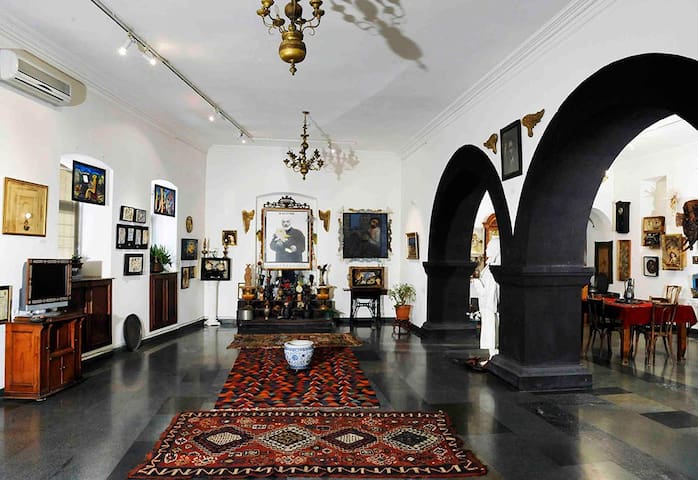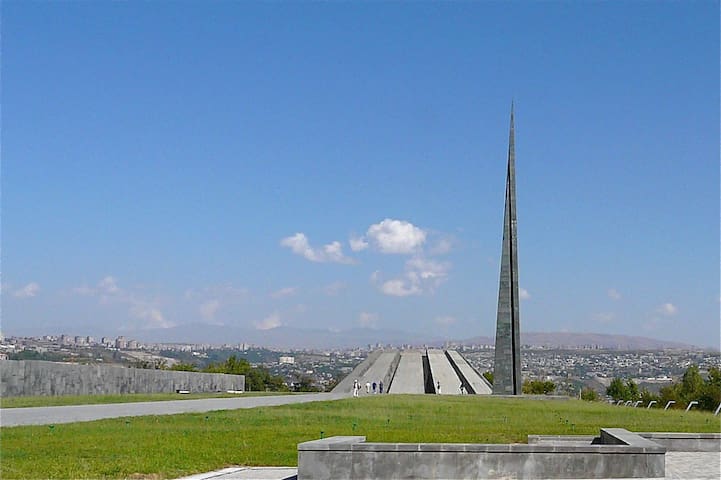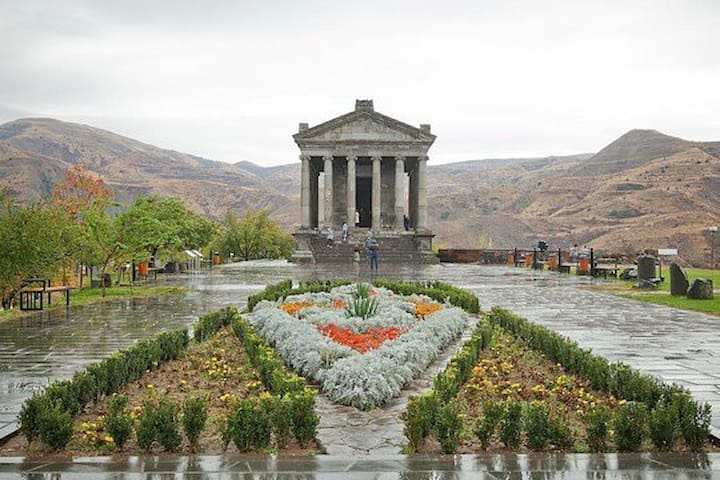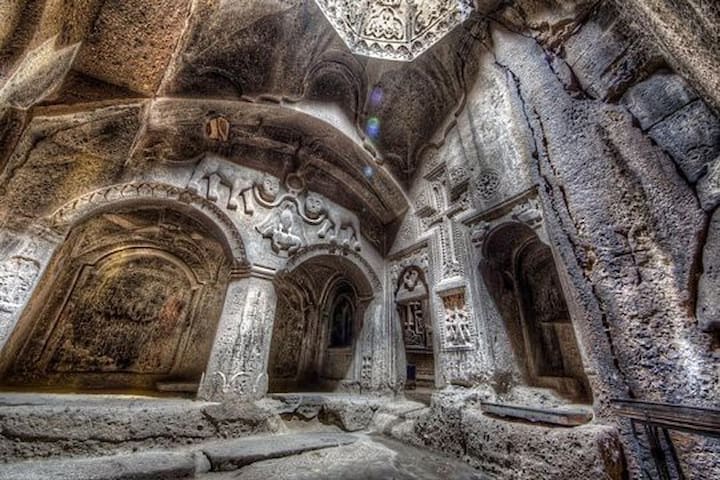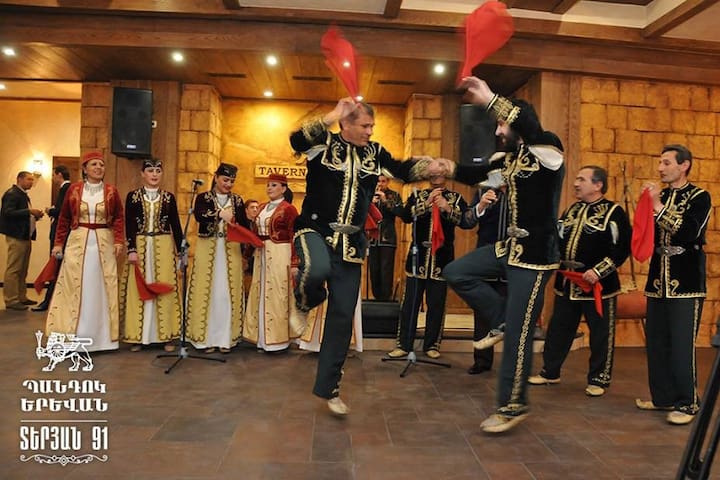Shopping
"Dalma Garden Mall" - it is the largest multi-functional shopping complex in Armenia. A wide selection of shops, entertainment, cafes and restaurants, modern design, a perfect combination of the latest architectural and engineering solutions, convenient location center - everything is provided for the comfort of visitors and tenants.
143 íbúar mæla með
Dalma Garden Mall
3 Tsitsernakaberd Hwy"Dalma Garden Mall" - it is the largest multi-functional shopping complex in Armenia. A wide selection of shops, entertainment, cafes and restaurants, modern design, a perfect combination of the latest architectural and engineering solutions, convenient location center - everything is provided for the comfort of visitors and tenants.
One of the few nice malls in Yerevan. Good selection of stores, free secure parking, cinemas, food court.
78 íbúar mæla með
Yerevan Mall
34 Arshakunyats AveOne of the few nice malls in Yerevan. Good selection of stores, free secure parking, cinemas, food court.
Sightseeing
https://youtu.be/xXOaxRGTsUE
Sergey Paradjanov was the author of several film-masterpieces which brought him world praise: "Shadows of Forgotten Ancestors" (1964), "The Colour of Pomegranates" or "Sayat-Nova" (1969), "The Legend of Suram Fortress" (1985) and "Ashik-Kerib" (1988). Parajanov’s contribution to the art of cinema is first and foremost his original poetic film-language, highly valued by his contemporaries. His aesthetic system also includes plastic art, based on traditions of Armenian, Eastern and European art.
The museum of S. Parajanov was founded by resolution of the government in 1988, after the first exhibition of his Artworks at the State Museum of Armenian Folk Art. At that time appropriate premises consisting of two buildings (one for the museum and the other for home of S. Parajanov) were allocated in the Ethnographic Center “Dzoragiugh”. However construction was delayed due to the earthquake of 1988 and the museum was opened in 1991.
The basis of the museum collection constitute 600 works of Parajanov - assemblages, flat and three-dimensional collages, drawings, dolls and film sketches, furniture, own things, which were transformed from Tbilisi to Yerevan during his lifetime.
In the course of years of its existence the museum storage has been replenished and today the number of subjects is 1500 units.
The museum also houses Parajanov's personal be longings and presents from his friends. An extensive correspondence of the film-director, including letters from L. Brik, A. Tarkovsky, J. Nikulin, V. Katanyan and other cultural figures is also kept in the museum’s archives.
Two memorial rooms are also re-created.
Parajanov’s works - assemblages, flat and three-dimensional collages, drawings, dolls and film sketches are his distinctive reaction to life and events around him, his aesthetic perception of the world.
His drawings and collages created in prison are exhibited in separate hall.
The Artist’s work has no direct analogies in the world art and amazes with its fantasy, wit and artistry. The use of various materials and objects imparts to it a special charm and brilliance.
The Soviet system suspended Parajanov from shooting films for almost 15 years, 5 of which (1973-1977 and 1982) were spent in prisons and “camps of severe regime.”
In the course of 27 years of its existence the museum has organised 64 exhibitions more than 30 countries - Cannes, Athens, Tokyo, Moscow, Kiev, Boston, Rome, London, Tehran, Peking, Paris, Sofia, Brazil, Canada, Vilnius, and other cities.
Parajanov Museum is one of the most popular museums in Yerevan.
It is open seven days a week from 10.30 a.m. till 5.00 p.m.
64 íbúar mæla með
Sergei Paradjanov Museum
Sergey Dzoragyugh 1st StSergey Paradjanov was the author of several film-masterpieces which brought him world praise: "Shadows of Forgotten Ancestors" (1964), "The Colour of Pomegranates" or "Sayat-Nova" (1969), "The Legend of Suram Fortress" (1985) and "Ashik-Kerib" (1988). Parajanov’s contribution to the art of cinema is first and foremost his original poetic film-language, highly valued by his contemporaries. His aesthetic system also includes plastic art, based on traditions of Armenian, Eastern and European art.
The museum of S. Parajanov was founded by resolution of the government in 1988, after the first exhibition of his Artworks at the State Museum of Armenian Folk Art. At that time appropriate premises consisting of two buildings (one for the museum and the other for home of S. Parajanov) were allocated in the Ethnographic Center “Dzoragiugh”. However construction was delayed due to the earthquake of 1988 and the museum was opened in 1991.
The basis of the museum collection constitute 600 works of Parajanov - assemblages, flat and three-dimensional collages, drawings, dolls and film sketches, furniture, own things, which were transformed from Tbilisi to Yerevan during his lifetime.
In the course of years of its existence the museum storage has been replenished and today the number of subjects is 1500 units.
The museum also houses Parajanov's personal be longings and presents from his friends. An extensive correspondence of the film-director, including letters from L. Brik, A. Tarkovsky, J. Nikulin, V. Katanyan and other cultural figures is also kept in the museum’s archives.
Two memorial rooms are also re-created.
Parajanov’s works - assemblages, flat and three-dimensional collages, drawings, dolls and film sketches are his distinctive reaction to life and events around him, his aesthetic perception of the world.
His drawings and collages created in prison are exhibited in separate hall.
The Artist’s work has no direct analogies in the world art and amazes with its fantasy, wit and artistry. The use of various materials and objects imparts to it a special charm and brilliance.
The Soviet system suspended Parajanov from shooting films for almost 15 years, 5 of which (1973-1977 and 1982) were spent in prisons and “camps of severe regime.”
In the course of 27 years of its existence the museum has organised 64 exhibitions more than 30 countries - Cannes, Athens, Tokyo, Moscow, Kiev, Boston, Rome, London, Tehran, Peking, Paris, Sofia, Brazil, Canada, Vilnius, and other cities.
Parajanov Museum is one of the most popular museums in Yerevan.
It is open seven days a week from 10.30 a.m. till 5.00 p.m.
This scientific and cultural institution occupies an area of 2,000 square meters. The three-stock building looks like a stone castle. On the 12 basement walls of the inner courtyard are engraved words by Henry Morgenthau, Anatol Franc, Frityof Nansen, Jak de Morgan, Valery Bryusov, Fayez El Ghuseyn, about the catastrophe of Armenian people. On the wall of the hall, is carved the map of Western Armenia with a 45-meter square, where are introduced the places of massacres and deportations. The museum is located in the south-western part of the Memorial Complex, completing already existing structures. The flat roof of the museum's building is a viewpoint where a view opens up to panorama of mount Ararat and Yerevan.
Within the framework of the events marking the 100th anniversary of the Armenian Genocide in 2011-2015 The reconstruction works of the memorial were held, The Tsitsernakaberd alley and the surrounding area were restored, the main building of the Museum-Institute was renovated, administrative part, the library, conference hall and archives were built. The renovation was implemented through “Tsitsernakaberd” charity foundation, the President of the Board of Trustees is President of the Republic of Armenia Serj Sargsyan. In April 21, 2015 official and ceremonial opening of new exhibition of Armenian Genocide Museum took place with the participation of RA President Serj Sargsyan, Members of the State Committee on Coordination of the events dedicated to the 100th anniversary of the Armenian Genocide, members of the Government and philanthropists of the museum. The architect of the Museum is Sashur Qalashyan. The new Scientific concept of three language exhibition (Armenian, Russian, English) was developed and implemented by the stuff of Armenian Genocide Museum-Institute, headed by Doctor of Historical Sciences, Director of AGMI, the secretary of the commission coordinating events dedicated to the 100th anniversary of the Armenian Genocide Hayk Demoyan. Lusine Matevosyan and Qristine Abrahamyan developed and implemented the interior design and design concept of the Museum halls. The museum expert group formed by the state committee coordinating the events dedicated to the 100th anniversary of the Armenian Genocide has provided advisory support to the works.
The exhibition area of the museum was expanded by two and a half times, making 2400 square meters, has 12 halls, instead of the former three halls. The exhibition consists of 50 main headings, in which are summarized thousands of new materials acquired during the last 7-8 years' collective work. Some of them are presented as print, as well as multimedia, projectors and touch screens. Also original and unique photos, books and documents are exhibited. For the first time in Armenia, new technologies, design approaches and solutions have been widely used in the world-wide museum practice. The content of the museum exhibits, textbooks and explanations are based on scientific and methodological developments in the field of genocide science in the past few years.
Over the course of more than twenty years, the museum had many visitors, including pupils, students, and thousands of tourists. The museum exhibits are provided to visitors through Armenian, Russian, English, French and German tours.
9 íbúar mæla með
Armenian Genocide Museum
This scientific and cultural institution occupies an area of 2,000 square meters. The three-stock building looks like a stone castle. On the 12 basement walls of the inner courtyard are engraved words by Henry Morgenthau, Anatol Franc, Frityof Nansen, Jak de Morgan, Valery Bryusov, Fayez El Ghuseyn, about the catastrophe of Armenian people. On the wall of the hall, is carved the map of Western Armenia with a 45-meter square, where are introduced the places of massacres and deportations. The museum is located in the south-western part of the Memorial Complex, completing already existing structures. The flat roof of the museum's building is a viewpoint where a view opens up to panorama of mount Ararat and Yerevan.
Within the framework of the events marking the 100th anniversary of the Armenian Genocide in 2011-2015 The reconstruction works of the memorial were held, The Tsitsernakaberd alley and the surrounding area were restored, the main building of the Museum-Institute was renovated, administrative part, the library, conference hall and archives were built. The renovation was implemented through “Tsitsernakaberd” charity foundation, the President of the Board of Trustees is President of the Republic of Armenia Serj Sargsyan. In April 21, 2015 official and ceremonial opening of new exhibition of Armenian Genocide Museum took place with the participation of RA President Serj Sargsyan, Members of the State Committee on Coordination of the events dedicated to the 100th anniversary of the Armenian Genocide, members of the Government and philanthropists of the museum. The architect of the Museum is Sashur Qalashyan. The new Scientific concept of three language exhibition (Armenian, Russian, English) was developed and implemented by the stuff of Armenian Genocide Museum-Institute, headed by Doctor of Historical Sciences, Director of AGMI, the secretary of the commission coordinating events dedicated to the 100th anniversary of the Armenian Genocide Hayk Demoyan. Lusine Matevosyan and Qristine Abrahamyan developed and implemented the interior design and design concept of the Museum halls. The museum expert group formed by the state committee coordinating the events dedicated to the 100th anniversary of the Armenian Genocide has provided advisory support to the works.
The exhibition area of the museum was expanded by two and a half times, making 2400 square meters, has 12 halls, instead of the former three halls. The exhibition consists of 50 main headings, in which are summarized thousands of new materials acquired during the last 7-8 years' collective work. Some of them are presented as print, as well as multimedia, projectors and touch screens. Also original and unique photos, books and documents are exhibited. For the first time in Armenia, new technologies, design approaches and solutions have been widely used in the world-wide museum practice. The content of the museum exhibits, textbooks and explanations are based on scientific and methodological developments in the field of genocide science in the past few years.
Over the course of more than twenty years, the museum had many visitors, including pupils, students, and thousands of tourists. The museum exhibits are provided to visitors through Armenian, Russian, English, French and German tours.
In the lives of our renowned medieval authors, special emphasis is put on their book-learning and ceaseless efforts to collect old manuscripts, create new ones, summarize and reassess the spiritual heritage of the past. Their devoted activity set an example for the future generations. Thus, starting with Mesrop Mashtots, the founder of the first matenadaran (“manuscript repository”), our bibliophiles and bibliographers created numerous matenadarans from the early Middle Ages to modern times. During centuries, they ramified and then became intertwined; as eternal values, they overcame all calamities and, as intellectual light, guided our people towards the future.
In this way the Mesrop Mashtots Matenadaran came into being; our torchbearers of culture, all generations, and the entire nation as a spiritual wholeness participated in its creation. It is the outcome of the powerful instinct of our great unity, unanimity, and survival. It is the warranty of our perpetuity.
Matenadaran – which is our identity, our banner, and our coat of arms. It is, indeed, a hymn that resonates eternally.
135 íbúar mæla með
Matenadaran
53 Mesrop Mashtoc pokhota In the lives of our renowned medieval authors, special emphasis is put on their book-learning and ceaseless efforts to collect old manuscripts, create new ones, summarize and reassess the spiritual heritage of the past. Their devoted activity set an example for the future generations. Thus, starting with Mesrop Mashtots, the founder of the first matenadaran (“manuscript repository”), our bibliophiles and bibliographers created numerous matenadarans from the early Middle Ages to modern times. During centuries, they ramified and then became intertwined; as eternal values, they overcame all calamities and, as intellectual light, guided our people towards the future.
In this way the Mesrop Mashtots Matenadaran came into being; our torchbearers of culture, all generations, and the entire nation as a spiritual wholeness participated in its creation. It is the outcome of the powerful instinct of our great unity, unanimity, and survival. It is the warranty of our perpetuity.
Matenadaran – which is our identity, our banner, and our coat of arms. It is, indeed, a hymn that resonates eternally.
Temple of Garni
garniThe Temple of Garni is a classical Hellenistic temple in Garni, Armenia. Reconstructed in the 1970s, it is the only known Greco-Roman colonnaded temple in Armenia. It is perhaps the best-known structure and symbol of pre-Christian Armenia. After the adoption of Christianity, all the pagan temples in Armenia were demolished except Garni. The reason how the temple could survive till nowadays is that the sister of the King TrdatIII, Kosrovdukht, had turned the place into her summer residence. The huge earthquake destroyed the defensive walls of the castle and the temple in 1679. The construction started in 1949. The temple was dedicated to Mythra, a deity popular in the Near East which became the patron goddess of the Roman Empire in the period before Christianity.
29 íbúar mæla með
Garni
Temple of Garni
garniThe Temple of Garni is a classical Hellenistic temple in Garni, Armenia. Reconstructed in the 1970s, it is the only known Greco-Roman colonnaded temple in Armenia. It is perhaps the best-known structure and symbol of pre-Christian Armenia. After the adoption of Christianity, all the pagan temples in Armenia were demolished except Garni. The reason how the temple could survive till nowadays is that the sister of the King TrdatIII, Kosrovdukht, had turned the place into her summer residence. The huge earthquake destroyed the defensive walls of the castle and the temple in 1679. The construction started in 1949. The temple was dedicated to Mythra, a deity popular in the Near East which became the patron goddess of the Roman Empire in the period before Christianity.
Monastery of Geghard
Geghard is a medieval monastery in the Kotayk province of Armenia, being partially carved out of the adjacent mountain, surrounded by cliffs. The site of the monastery has been known from pre-Christian times, when people worshiped at springs at the site, especially the one inside one of the churches craved into the rock. As a monastic complex it came forward in the beginning of the 4th century founded by Gregory the yari220Illuminator that was known as “Ayrivank” or “Monastery of Cave.” At its height in the 13th century, Geghard monastery benefited from patronage by princely families and was a pilgrimage site, not least for its reliquaries of the Holy Lance, the spear used by a Roman soldier to pierce the crucified Christ. This reliquary gave the monastery its current name Geghardavank (Monastery of the Spear). Another relic was a wooden fragment said to have been a piece of Noah’s Ark.
Geghard Monastery Road
Geghard Monastery RoadMonastery of Geghard
Geghard is a medieval monastery in the Kotayk province of Armenia, being partially carved out of the adjacent mountain, surrounded by cliffs. The site of the monastery has been known from pre-Christian times, when people worshiped at springs at the site, especially the one inside one of the churches craved into the rock. As a monastic complex it came forward in the beginning of the 4th century founded by Gregory the yari220Illuminator that was known as “Ayrivank” or “Monastery of Cave.” At its height in the 13th century, Geghard monastery benefited from patronage by princely families and was a pilgrimage site, not least for its reliquaries of the Holy Lance, the spear used by a Roman soldier to pierce the crucified Christ. This reliquary gave the monastery its current name Geghardavank (Monastery of the Spear). Another relic was a wooden fragment said to have been a piece of Noah’s Ark.
Sevan is the gem of Armenia, especially in summer. Its a mountainous lake with great view, excellent fish and fresh breeze.
46 íbúar mæla með
Lake Sevan
Sevan is the gem of Armenia, especially in summer. Its a mountainous lake with great view, excellent fish and fresh breeze.
Food scene
Presenting Armenian cuisine in an innovative and modern way. The formation of a unique setting with harmonious contrasts is at the heart of the restaurant’s creation, a meeting point of vintage design and Armenian cuisine.
The core of the Lavash concept includes a revival of the forgotten Armenian tradition of breakfast wraps, and the dissemination of the beautiful culture of the morning meal.
Lavash hopes its customers have a good time and enjoy a delicious meal in its indoor and outdoor sections. On the first floor, you can watch the beautiful process of how fresh puri bread, gata and, of course, lavash are baked in a tonir. On the second floor of the restaurant, there is a private hall for company parties or other special events.
81 íbúar mæla með
Lavash.Restaurant
21 Tumanyan StPresenting Armenian cuisine in an innovative and modern way. The formation of a unique setting with harmonious contrasts is at the heart of the restaurant’s creation, a meeting point of vintage design and Armenian cuisine.
The core of the Lavash concept includes a revival of the forgotten Armenian tradition of breakfast wraps, and the dissemination of the beautiful culture of the morning meal.
Lavash hopes its customers have a good time and enjoy a delicious meal in its indoor and outdoor sections. On the first floor, you can watch the beautiful process of how fresh puri bread, gata and, of course, lavash are baked in a tonir. On the second floor of the restaurant, there is a private hall for company parties or other special events.
The cuisine of a region is part of its larger culture and an evidence of the preferences that evolve with time due to contacts and historical developments. Being a unique part of the national identity the cuisine also experiences different influences and cannot be restricted by the traditions of one culture or one nation. Probably this is why since Tavern Yerevan’s foundation we tried to combine the best traditions of Armenian and Caucasian cuisines in our restaurant. Many of the Caucasian dishes have been accepted by Armenians with time and have become an integral part of the Armenian menu. Since, the very beginning our mission was to offer our customers dishes that are palatable for our customer from both culinary and cultural perspective, but are also slightly different. This is, though, only part of our comprehensive approach. At Tavern Yerevan we use the highest quality fresh products supplied by our partner farmers and producers. We are extremely consistent in ensuring highest professionalism and service quality of our serving staff.
With regards to pork our restaurant is also very selective. We only serve the meat of female pigs that are up to 30 kilos and are kept in pens with special conditions. These criteria are essential as they result in softer and tenderer meat qualities with no odor specific to pigs and with a balance between meat and fat, a feature which is highly valued by cooks in regards to pork.
I would like to believe that thanks to this approach Tavern Yerevan has become the embodiment of delicious food and a pleasant environment for many of our customers. Quoting one of our customers, “We feel at home here, as this is a place with an easy environment where fresh and tasty food is always in supply”.
40 íbúar mæla með
Tavern Yerevan
91 Teryan StreetThe cuisine of a region is part of its larger culture and an evidence of the preferences that evolve with time due to contacts and historical developments. Being a unique part of the national identity the cuisine also experiences different influences and cannot be restricted by the traditions of one culture or one nation. Probably this is why since Tavern Yerevan’s foundation we tried to combine the best traditions of Armenian and Caucasian cuisines in our restaurant. Many of the Caucasian dishes have been accepted by Armenians with time and have become an integral part of the Armenian menu. Since, the very beginning our mission was to offer our customers dishes that are palatable for our customer from both culinary and cultural perspective, but are also slightly different. This is, though, only part of our comprehensive approach. At Tavern Yerevan we use the highest quality fresh products supplied by our partner farmers and producers. We are extremely consistent in ensuring highest professionalism and service quality of our serving staff.
With regards to pork our restaurant is also very selective. We only serve the meat of female pigs that are up to 30 kilos and are kept in pens with special conditions. These criteria are essential as they result in softer and tenderer meat qualities with no odor specific to pigs and with a balance between meat and fat, a feature which is highly valued by cooks in regards to pork.
I would like to believe that thanks to this approach Tavern Yerevan has become the embodiment of delicious food and a pleasant environment for many of our customers. Quoting one of our customers, “We feel at home here, as this is a place with an easy environment where fresh and tasty food is always in supply”.
Definitely worth trying. Probably the best Khinkali in Yerevan.
In 2004 in the heart of Yerevan there was opened a little cosy corner, where khinkali lovers could taste the tastiest khinkali in warm atmosphere.
During the twelve years by the devoted efforts of staff this small corner expanded into a high-class restaurant, which is ready to host not only Armenians but also guests from other countries.
Due to their highly appreciated and demand "Tumanyan Khinkali" restaurant opened its doors in the center of Glendale city, California.
"Tumanyan Khinkali" restaurant brought old traditions to life. Being at the crossroads of ancient and modern times and due to its pleasant interior and friendly staff, has become a second home for khinkali lovers. A Place where everyone can enjoy a preferably khinkali in warm and friendly atmosphere, reserve a table, arrange any event. It is solely due to the efforts of the cooks you can choose the ones which you prefer from the wide range khinkali.
The restaurant has an individual approach to each guest. The proof of that is a special hall for non-smokers, by which the "Tumanyan Khinkali" got a special certificate form UCAID.
In 2015 "Tumanyan Khinkali" restaurant made a surprise for its guests, opening an outdoor terrace, where the guests can eat khinkali and enjoy the summer evenings.
16 íbúar mæla með
Khinkali
21/1 Tumanyan StDefinitely worth trying. Probably the best Khinkali in Yerevan.
In 2004 in the heart of Yerevan there was opened a little cosy corner, where khinkali lovers could taste the tastiest khinkali in warm atmosphere.
During the twelve years by the devoted efforts of staff this small corner expanded into a high-class restaurant, which is ready to host not only Armenians but also guests from other countries.
Due to their highly appreciated and demand "Tumanyan Khinkali" restaurant opened its doors in the center of Glendale city, California.
"Tumanyan Khinkali" restaurant brought old traditions to life. Being at the crossroads of ancient and modern times and due to its pleasant interior and friendly staff, has become a second home for khinkali lovers. A Place where everyone can enjoy a preferably khinkali in warm and friendly atmosphere, reserve a table, arrange any event. It is solely due to the efforts of the cooks you can choose the ones which you prefer from the wide range khinkali.
The restaurant has an individual approach to each guest. The proof of that is a special hall for non-smokers, by which the "Tumanyan Khinkali" got a special certificate form UCAID.
In 2015 "Tumanyan Khinkali" restaurant made a surprise for its guests, opening an outdoor terrace, where the guests can eat khinkali and enjoy the summer evenings.
Borgartillaga
Ekki missa af
Metro/Subway is convenient to move around the city.
It is quite inexpensive, clean and runs from 6 to midnight.
Siðir og menning
Water festival, known as Vardavar in Armenia!
http://armeniagoing.com/event-details/136
Vardavar water festival presents different games, dances, songs, and of course pouring water on each other. People of all ages take part in this expected holiday, and no one has a chance to escape and stay dry in the streets of Yerevan during this day. However, in the July heat such a holiday of water is exactly what you need. So, if someone pour water on you, do not be offended, because it is much more interesting to pour water in a pail or a mug and become a participant in Vardavar yourself!


